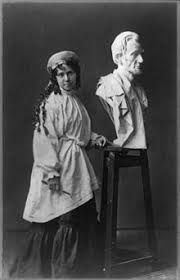Vinnie Ream, America’s Youngest Sculptress
Listen to the Recess! Clip
| Author | John Cech |
| Air Date | 9/25/2003 |

Vinnie Ream, America’s Youngest Sculptress Transcript
Vinnie Ream was the youngest American artist ever to receive a commission from the federal government. In 1866, the United States Congress passed a resolution which offered the 19-year-old a remarkable opportunity, to create a life-sized statue of the late Abraham Lincoln, awarding her the sum of $10,000 dollars upon completion of her work.
It was a sensational decision, and not without its debates. The attractive, diminutive Vinnie, with her curling, cascading dark ringlets was accused of having charmed and flattered the elderly law-makers into giving her this coveted honor. She was charged with being unladylike and bold because she shook hands with men and met their gaze directly. She was assailed because she was still a teenager from a struggling Western family — a rough sister of the range — not a European-educated daughter of privilege.
She had been born in Madison, Wisconsin, on September 25, 1847. Her father drew maps for the Land Office and was active in state politics before he moved the family to the Kansas Territory, where he dabbled in real estate, while Vinnie’s genius for modeling life-like statues from river-botton clay, for painting, for playing music and composing songs and poems began to flourish and draw public acclaim. The Civil War found the Reams in Washington, where Vinnie’s father hoped his fortunes would change, and where Vinnie, at age 16, was taken to meet the sculptor Clark Mills, who had a studio in the basement of the Capitol building. Mills was working on the casting for the Statue of Freedom that would eventually grace the Capitol Dome. On their first meeting, Mills tossed a lump of clay at Vinnie and challenged her to do something with it. Within an hour, she had modeled a head of an Indian chief, feathers and all, and the impressed Mills took her on as his assistant.
She admired Lincoln enormously and wanted to sculpt him. He had heard she was a poor, aspiring artist from the west, and is reputed to have said, “Poor, is she? Well that’s nothing agin’ her.” And so they met. And the president who didn’t want to waste any more time sitting for artists or photographers, let her sketch him. It took her more than five years after Lincoln’s death to complete the marble statue, which today stands in the Capital Rotunda. Even George Armstrong Custer was impressed with her achievement and wrote her that “Your victories are lasting and unlike mine are not purchased at the expense of the life-blood of fellow creatures, leaving sorrow and desloation in their track.” Instead, in the smooth, cool clay and stone she worked throughout her long life, Vinnie left a legacy of quiet dignity and beauty.